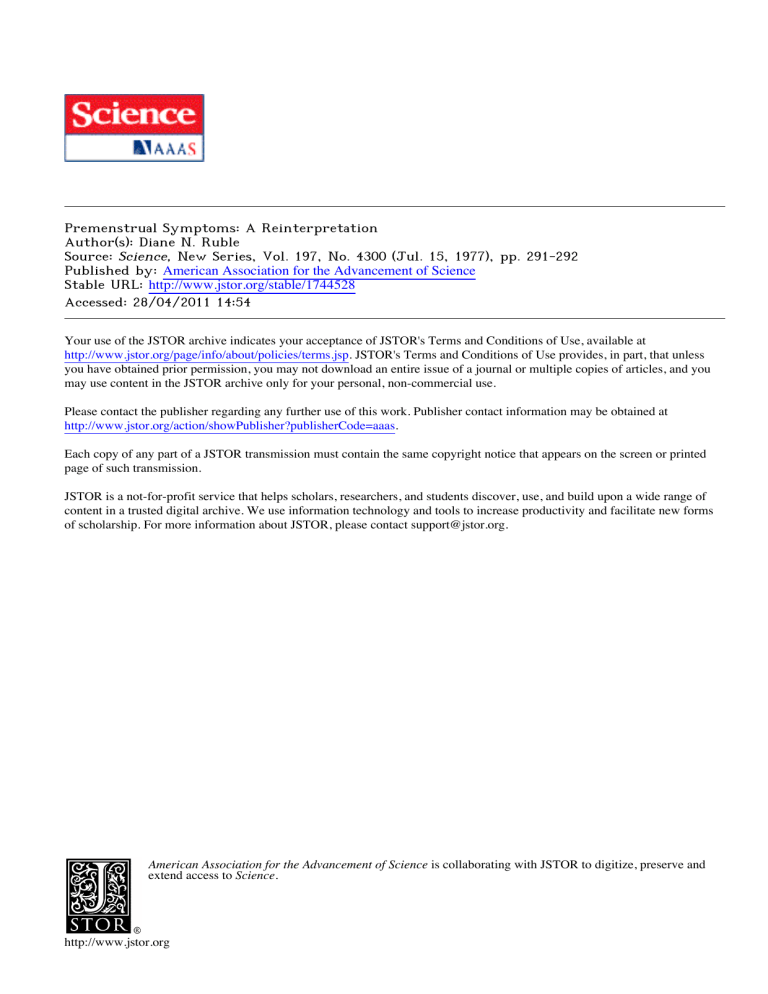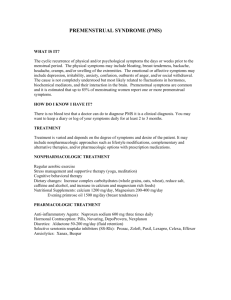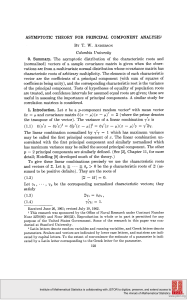
American Association for the Advancement of Science http://www.jstor.org/stable/1744528 . Your use of the JSTOR archive indicates your acceptance of JSTOR's Terms and Conditions of Use, available at . http://www.jstor.org/page/info/about/policies/terms.jsp. JSTOR's Terms and Conditions of Use provides, in part, that unless you have obtained prior permission, you may not download an entire issue of a journal or multiple copies of articles, and you may use content in the JSTOR archive only for your personal, non-commercial use. Please contact the publisher regarding any further use of this work. Publisher contact information may be obtained at . http://www.jstor.org/action/showPublisher?publisherCode=aaas. . Each copy of any part of a JSTOR transmission must contain the same copyright notice that appears on the screen or printed page of such transmission. JSTOR is a not-for-profit service that helps scholars, researchers, and students discover, use, and build upon a wide range of content in a trusted digital archive. We use information technology and tools to increase productivity and facilitate new forms of scholarship. For more information about JSTOR, please contact support@jstor.org. American Association for the Advancement of Science is collaborating with JSTOR to digitize, preserve and extend access to Science. http://www.jstor.org cm2 flasks containinga confluent monolayer. The finalethanolconcentrationwas 0.04M.The monolayer was incubatedfor 1 hour at 37?C. PGE levels in the media were then determined by radioimmunoassay(14) with antiserumto PGE, [3H]PGE2(from New EnglandNuclear), and'goat antibody to rabbit y-globulin (from ClinicalAssays, Inc.). In inhibitorexperiments, cells were incubatedwith indomethacin(IM)for 15 minutes. 12. G. E. Milo, W. B. Malarkey,J. E. Powell, J. R. BlakesleeandD. S. Yohn,In Vitro12, 23 (1976). 13. C20:3(Nuchek Prep) andC*20:4(Nuchek Prep) were monitoredfor the absenceof fattyacidperoxides by thin-layerchromatographyon silica gel G with the use of a heptane, ether, acetic acid system (50: 50: 0.8, by volume)and a potassiumiodide-starchspray.Only peroxide-free fatty acids were used. PGEI was supplied by Upjohn, and PGE2was suppliedby Ono PharmaceuticalCo. The smooth muscle cell monolayer was washed three times with incomplete MEM, rinsed with 5.3 x 10-4MEDTA in Dulbecco's phosphatebufferedsaline (without Ca or Mg) at pH 7.2, and treatedwith 0.1 percent trypsin(E.C. 3.4.21.4) (WorthingtonBiochemi- cal). Trypsinizedcells were centrifugedat 650g for 7 minutes, and the pellet was suspendedin complete cloning media. Cells were seeded at 4 x 103cell/25 cm2.Viabilityat time of seeding was establishedin randomsamplesby a trypan blue dye exclusion test. Platingefficiency was establishedin representativewells at 24 hours by stainingwithEhrlichhematoxylin.Fattyacids and prostaglandinswere dissolved in ethanol, dilutedwith completemedia,and addedto cloning plates seeded for 24 hours.The finalethanol concentrationwas 0.04M. Smooth muscle cell cultureswere incubatedwith the fatty acid solutions for the durationof the experiment. 14. L. Levine, R. M. GutierrezCernosek, H. Van Vunakis, J. Biol. Chem. 246, 6782 (1971); L. Levine, P. M. Hinkle, E. F. Voelkel, A. H. Tashjian, Jr., Biochem. Biophys. Res. Commun. 47, 888 (1972). 15. Supportedin part by NationalHeart and Lung Institute grant 11897. We thank J. Berno, T. McMichael, D. Riegner, and I. Clement for technicalassistance, and Dr. L. Levine for the supply of antiserumto PGE. 17 February1976;revised 9 May 1977 Premenstrual Symptoms: A Reinterpretation Abstract. Conclusions regarding the physiological basis and disruptive effects of premenstrual symptoms may be biased because of the reliance on self-report questionnaires as a source of data. In order to examine this possible bias, women's perceptions of their cycle phase were separated experimentally from actual cycle phase. Women who were led to believe that they were premenstrual reported experiencing a significantly higher degree of several physical symptoms, such as water retention, than did women who were led to believe they were intermenstrual. Thus, because of these psychosocial influences on symptom reports, it seems necessary to reexamine previous conclusions regarding the magnitude of menstrual-related changes as well as their physiological basis. A variety of physical and psychological symptoms, such as cramps, painful breasts, irritability,and depressionhave been associated with the premenstrual and menstrualphases of women's reproductive cycles (1-4). These uncomfortable symptoms have generally been interpretedas reflectingunderlyingphysiological changes which accompany the menstrualcycle (2, 3). However, a major source of evidence regarding cyclic changes has been women's self-reports of symptoms experienced at various phases of the menstrualcycle (1). The data presentedin this reportsuggest that self-reportstudies may have led to exaggerated conclusions regardingthe kinds of symptoms experienced, the magnitude of cyclic changes, and the physiological basis of premenstrual symptoms. Although studies based on women's self-reportsof symptomshave found cyclic differences, studies based on less subjective measures have frequently found no differences. For example, in spite of strong beliefs that women gain weight and retain water premenstrually (4), carefully controlled observations have shown little cyclic variation in these symptoms(5). Furthermore,investigatorswho finda premenstrualincrease in these variables usually also report a 15 JULY 1977 midcyclepeak (5, 6). In addition,according to a recent review (7), most objective measuresof performance(such as athletics or tests of reasoning)fail to show an impairment associated with the menstrualcycle, even though8 to 16 percent of the women themselves believed that theirperformancesare affectednegatively by their cycles. In view of the inconsistentfindingsregarding menstrual-relatedsymptoms, it becomes necessary to questionthe validity of self-reportstudies. That is, self-report measuresare susceptibleto various kinds of biases and may reflect cultural beliefs concerning the kinds of symptoms women experience at various phases of the cycle. This reportpresents a study in which a woman's actual cycle phase was separated experimentally from her belief concerning her cycle phase. Womenwere told that it was possible, throughnew scientifictechniques, to predict the expected date of menstruation.In this way, it was possible to assign them to "premenstrual"and "intermenstrual"groupson a randombasis. It was hypothesized that the different groups of women would report experiencingdifferentlevels of menstrual-related symptoms even though they were all tested at about a week before the onset of menstruation. Subjects were 44 women undergraduatesat Princeton University, aged 18 to 24, who were not taking oral contraceptives at the time of the study nor had taken them within the previous 3 months. Variabilityin the length of their cycles did not exceed 2 weeks. Upon initial telephonecontact, subjectswere told they were participatingin contraceptionrelated research in which a new technique for predictingthe expected date of menstruationfrom an electroencephalogram (EEG) was being surveyed on young women, having been successfully tested with older women. Brief menstrual histories were also obtained. Later, subjects were telephoned to arrange an appointment. Unknown to the subject, the scheduled day of testing was chosen specifically to correspondto the sixth or seventh day (as estimated from her menstrual history) before her next menses. The research was conducted in the university infirmaryin two connecting rooms, one of which containedan examining table and a large oscilloscope with EEG electrodes attached to it. Subjects were greeted by the first experimenter, given a sheet explainingthe purpose of the study, and asked to complete a short medical history. The experimenterthen took the temperatureand blood pressure of the subject and explained the EEG procedure. Electrodes were attached to the subject's forehead with beautician's tape, and the experimenterproceededto "run" the simulated EEG machine. After 4 minutes, the electrodes were removed, and the experimenterpretended to readthe output. She then informedthe subject, according to the experimental group to which she had been randomly assigned, that (i) the subject was "premenstrual"and her period was due in 1 or 2 days (premenstrualgroup)or that (ii) she was "intermenstrual"and her period was not expected for at least a week to 10 days (intermenstrualgroup), or (iii) she was given no informationat all about the expected date of menstruation(control group). The subject was then instructed to go into an adjoining room, where a second experimenter,who did not know to which experimentalgroup the subject belonged, administeredthe Moos (2) Menstrual Distress Questionnaire (MDQ), consisting of 48 items, 46 of which form eight clusters of symptoms (8). Subjects were asked to rate the extent to which they had experienced any of the symptoms in the last day or two. Immediately afterward, subjects were given information describing the true intent of the experiment and were questioned concerning any suspicions 291 Table 1. Mean ratings on MDQ ? the standard error of the means. The ratings ranged from 1 (not at all) to 6 (extremely). Experimental condition Variable Intermenstrual (N= 14) Premenstrual (N= 15) Control (N= 15) P* + ? + + + + + + <.01O <.05T Scales Water retention Pain Negative affect Concentration Behavioral change Autonomic reactions Arousal Control Change in eating habits Sexual arousal 2.62 2.32 3.13 2.51 2.57 1.45 3.35 1.56 + + + + + + + + 0.29 0.17 0.32 0.27 0.38 0.18 0.31 0.19 1.54 1.88 3.10 2.20 2.23 1.27 3.06 1.41 + + + + + + + + 0.12 0.17 0.30 0.19 0.23 0.08 0.22 0.14 2.35 2.12 2.44 2.39 2.92 1.18 3.09 1.57 0.31 0.21 0.25 0.24 0.27 0.07 0.30 0.15 Individual items 1.57 ? 0.27 2.93 + 0.51 2.93 ? 0.44 <.025t 3.60 + 0.42 3.20 + 0.48 <.05 t 2.50 + 0.40 *Levels of significancefor t-tests between premenstrualand intermenstrualgroups. tTwo-tailedtest. they might have about the manipulations (9). They were also contacted later to find out the actual day of onset of menstruation, which did not differ across groups (P > .25). The MDQ was selected as the dependent variable because it is one of the most frequently used instruments in selfreport studies and has yielded reasonably consistent results. Previous research has shown that water retention, pain, and negative affect are the scales that show the greatest premenstrual as compared to intermenstrual differences (2-4, 10, 11). In addition, one of the individual items, "change in eating habits," has also shown a very strong association with the premenstrual phase in a sample very similar to that described here (11). Thus, it was predicted that women who thought they were premenstrual would report experiencing a higher level of water retention, pain, negative affect, and change in eating habits, as compared to women who thought that they were intermenstrual. Scale scores were created for each subject by summing the items in each of the eight scales identified by Moos and dividing by the number of completed items in each scale (12). An examination of the means for these eight scales plus the two individual items (Table 1) reveals a pattern consistent with the predictions; that is, symptom ratings of "premenstrual" women were higher than those of "intermenstrual" women. Statistical analyses revealed that these differences attained significance for three of the four predicted variables: water retention, 292 tOne-tailedtest. pain, and change in eating habits. Furthermore, the magnitude of the mean differences for most scales was very similar to that reported in previous research (2, 4, 10, 11). The means for the control group either generally fell in between the two other groups or were closer to the premenstrual group's means. Possibly, the women given no information about their cycle phase perceived themselves as premenstrual at 6 or 7 days before the onset of their next period. One other comparison reached significance-sexual arousal. This result, while not specifically predicted, is consistent with some previous reports of cyclic changes in sexual interest (13). Contrary to predictions, ratings for negative affect did not approach significance. Although one might argue that the results of this study are partly due to implicit demands for the women to report symptoms consistent with their cycle phase, similar "demands" are present in previous self-report studies. That is, subjects are asked to respond to a series of items identified as possible menstrual symptoms. Indeed, demand characteristics represent a major problem affecting the validity of self-report measures. These results question previous accounts of menstrual cycle-symptom associations in two respects. First, it may be misleading to assume that responses on a self-report scale accurately represent the nature and extent of changes accompanying the menstrual cycle. Secinterond, previous physiological pretations of premenstrual symptoms must be reevaluated, since cyclic dif- ferences in symptoms were found for women who only believed they were premenstrual or intermenstrual. The results reported here do not suggest that women never experience pain or water retention nor that such symptoms never accompany the premenstrual phase. Instead, it appears that learned associations or beliefs might lead a woman either to overstate what she is actually experiencing or to perceive an exaggeration of naturally fluctuating bodily states (for example, pain and weight changes) when she believes she is premenstrual. This interpretation is consistent with suggestions in other research concerning the importance of psychosocial factors in women's experience of menstruation (4, 11, 14). In conclusion, these results show that psychosocial factors can influence reports of menstrual-related symptoms. In conjunction with inconsistent results from other kinds of studies, these data suggest that the extent to which psychobased logically or physiologically changes (or both) accompany the premenstrual phase must remain an open question. DIANE N. RUBLE Department of Psychology, Princeton University, Princeton, New Jersey 08540 Referencesand Notes M. B. Parlee,Psych. Bull. 80, 454 (1973). R. H. Moos, Psychosom.Med. 30, 853 (1968). S. Silbergeldet al., ibid. 33, 411 (1971). M. B. Parlee,ibid. 36, 229 (1974). J. Bruce and G. F. M. Russell,Lancet 1962-1I, 267 (1962);P. E. Watsonand M. F. Robinson, Br. J. Nutr. 19, 237 (1965). 6. D. S. Janowsky,S. C. Berens,J. M. Davis, Psychosom. Med. 35, 143(1973). 7. B. Sommer,ibid. p. 515. 8. The two items not groupedwere "changein eating habits" and "sexual arousal." The latter was not partof the originalscale but was included in a later publication(3). 9. Onlyone subjectquestionedthe use of the EEG manipulation.Two others expressed general suspiciousnessabout psychology experiments. Eliminatingthese subjects from the analyses madeno differencein the results. 10. G. H. Grubaand M. Rohrbaugh,Psychosom. Med. 37, 265 (1975); L. A. Wilcoxon, S. L. Schrader,C. W. Sherif,ibid. 38, 399 (1976). 11. J. Brooks, D. Ruble,A. Clarke,ibid., in press. 12. Previousresearchwith the MDQ has typically presentedmeantotalscoresfor the MDQscales. Meanitem scores were used in the presentanalyses because this procedureallows for comparisons across the scales, which vary in the numberof items included. 13. M. Ivey and J. M. Bardwick,Psychosom.Med. 30, 336 (1968);G. S. Seward,Psychol. Bull. 31, 153(1934). 14. R. K. Koeske and G. F. Koeske,J. Pers. Soc. Psychol. 31, 474 (1975); K. E. Paige, Psychosom. Med. 33, 515(1971);J. Rodin,J. Pers. Soc. Psychol. 33, 345 (1976). 15. Supportedby NIMH biomedicalsupportgrant andby NSF (SOC76-02137).I thankM. C. Kamin for technical assistance;J. Brooks, N. S. Feldman, B. L. Jacobs, and T. L. Ruble for readingthe manuscript;and A. Clarkefor help in all phases of the research. 13 October1976;revised 16 March1977 1. 2. 3. 4. 5. SCIENCE, VOL. 197

